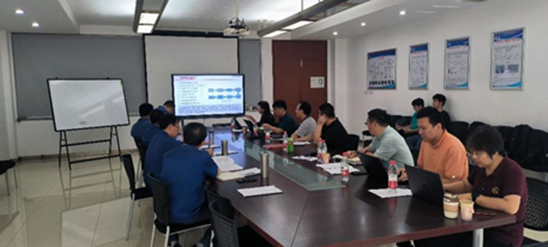
The research project of Heye Technology " Numerical Simulation of Temperature Control, Forging, Rolling, and Controlled Cooling Processes fo
The project titled "Numerical Simulation of Temperature Control, Forging, Rolling, and Controlled Cooling Processes for Tool Steel" conducted by Iron & Steel Research Institute An Tai Technology and He Ye Technology was successfully completed on September 4, 2023. The project included a technical training and acceptance phase, which took place from August 28 to September 4, 2023, at He Ye Technology. Key personnel from He Ye Technology, including Executive Deputy General Manager Liang Jingbin, Chief Technical Expert Wu Lizhi, Chief Process Engineer Shao Qingli, and Director of the Technical Research and Development Department You Xiaodong, were present during the project acceptance. Seven teachers and graduate students from University of Science and Technology Beijing attended the acceptance meeting.
The project focused on materials genome engineering, integrating the correlation between composition, process, structure, and properties, and adopting a multiscale analysis approach. The non-uniformity of microstructure, particularly the non-uniform distribution of carbides, plays a significant role in the performance of high-speed steel. Improving the production quality of high-speed steel is a strategic goal for He Ye Technology. The project conducted a comprehensive analysis of the entire process to understand the influence of each stage on the microstructure (carbides) of high-speed steel. This involved studying the temperature field, strain field, stress field, and microstructure field in the high-speed steel billet during each process, enabling a quantitative assessment of the impact of process factors and parameters on the quality of high-speed steel products. This, in turn, led to improvements in the production process to enhance product quality.
Before the acceptance meeting, the teachers from University of Science and Technology Beijing provided comprehensive technical training to the staff at He Ye Technology. The training covered various stages of the production process for M2 and M42 high-speed steels, including forging, rolling, and spheroidization annealing. The content encompassed both theoretical concepts and practical operations, such as simulation of the forging process for M42, modeling of the heat-mechanical coupling process for φ315 and φ360 electroslag ingot rapid forging of 140 and 170 square billets, and obtaining temperature, strain, stress, and microstructure fields for full-size forged components for later microstructure simulation and data transfer for multi-pass forging. Other topics included simulation of the rolling process for M42 steel, addressing the data transfer issue between multiple-pass rolling heat-structure coupling simulation, modeling the entire process of roughing and continuous rolling for M42 high-speed steel, and achieving data transfer between macroscopic computation and microstructure property simulation. Additionally, the training covered simulations of M42 steel microstructure evolution, introducing simulation models for high-speed steel matrix grain evolution, deformation induced phase transformation, and carbide spheroidization kinetics.

Prof. Zhang Cong presented optimization methods for spheroidization annealing processes of high-speed steel, accurate forecasting of matrix grain size during the heating process, and demonstrated the optimization and control of spheroidization annealing temperature and time. Prof. Zhang Ruijie explained the thermal deformation behavior of M42 steel, addressing the limitation of the traditional Arrhenius equation in considering strain, and introducing a rheological constitutive equation with strain compensation to improve the accuracy of predicting rheological stress. Prof. Liu Xunliang provided an introduction to in-furnace combustion and atmosphere flow, including the three-dimensional physical-mathematical models for in-furnace combustion processes and bottom-roll furnace flow and heat transfer processes. The distribution patterns of velocity, temperature, and concentration fields in the furnace were obtained. Various scenarios, such as single-burner, three-burner, and adding billets for heating, were analyzed to provide a reference for optimizing operating parameters for the two furnace types. Prof. Dou Ruifeng explained the efficient modeling methods for three-dimensional transient heat transfer in the furnace and introduced the black-box experiment, detailing two sets of numerical simulation software developed. These steps laid a solid foundation for optimizing heat transfer processes in the furnace.
On September 4th, the project acceptance took place. Before the meeting began, Engineer Li Dong from He Ye Technology provided a brief introduction to the project. Prof. Yin Haiqing presented a summary of the project's accomplishments, including the construction of constitutive equations for high-speed steel materials, dynamic recrystallization behavior, numerical simulation and verification of heating processes in chamber and step furnaces, simulation of rolling processes, modeling of spheroidization annealing, software models for isothermal processing, simulation of grain growth during isothermal processes, numerical simulation of forging and rolling processes, prediction of carbide characteristics during deformation processes, deformation induced phase transformation during rolling, and calculation of product hardness. The project utilized data obtained from simulations of temperature fields in heating furnaces, simulations of forging and rolling processes, and numerical simulation of spheroidization annealing processes to establish machine learning models for rapid performance prediction of high-speed steel.
The expert panel in attendance asked questions and the teachers provided detailed responses. The experts acknowledged the work done by the University of Science and Technology Beijing project team and unanimously agreed that the project had passed the acceptance. In the concluding discussions, the experts and teachers explored the application of full-process numerical simulation technology in the steel industry and agreed that further work should continue, aiming for intelligent optimization control along the entire production chain.

